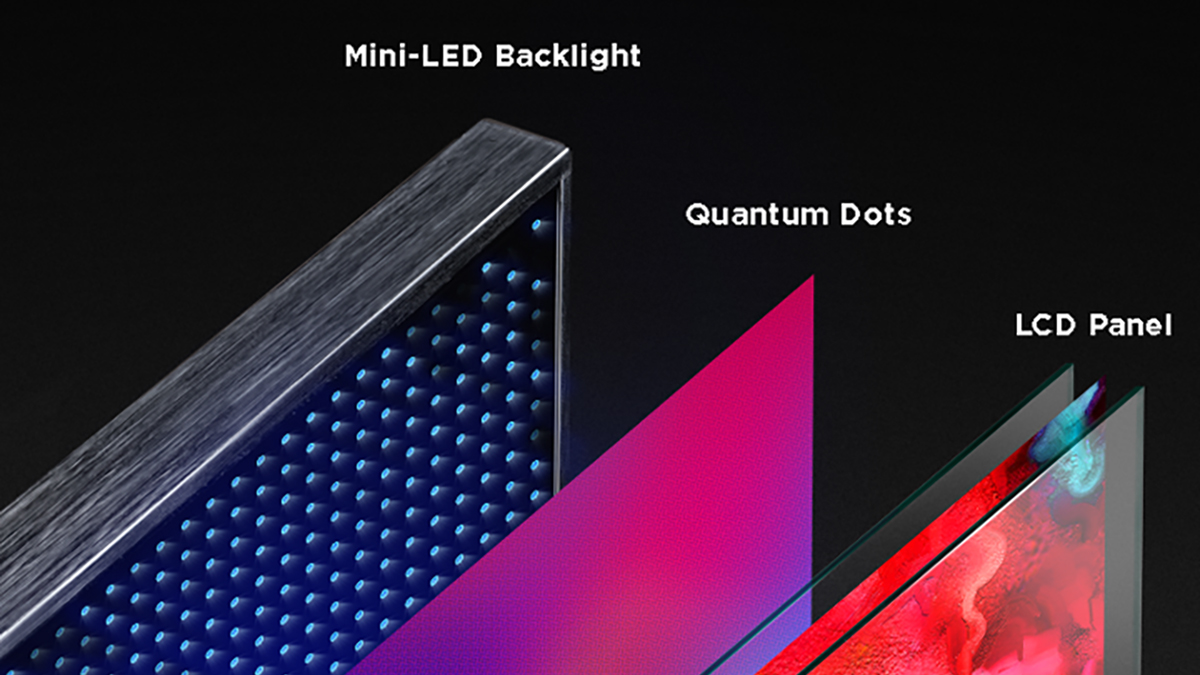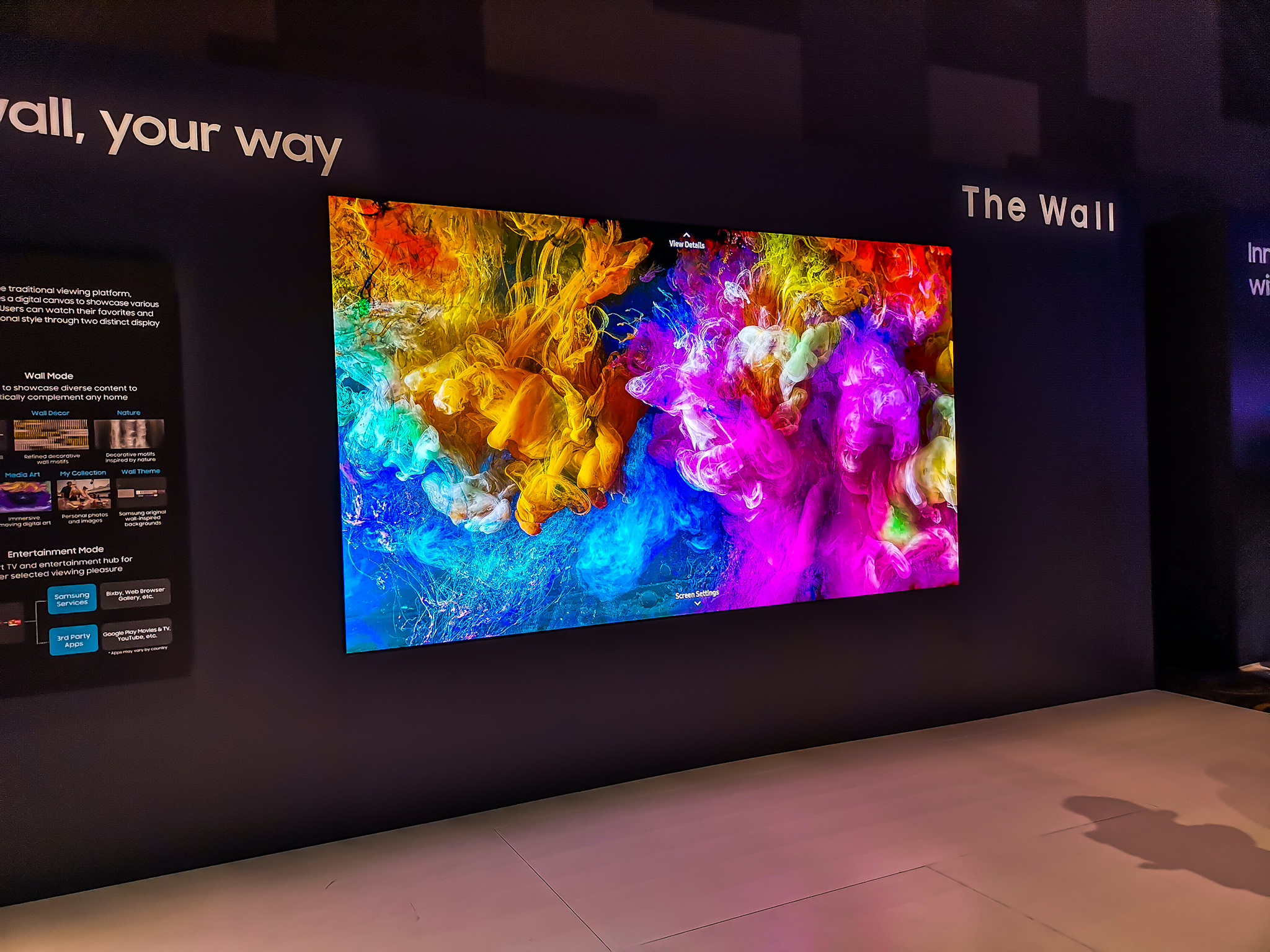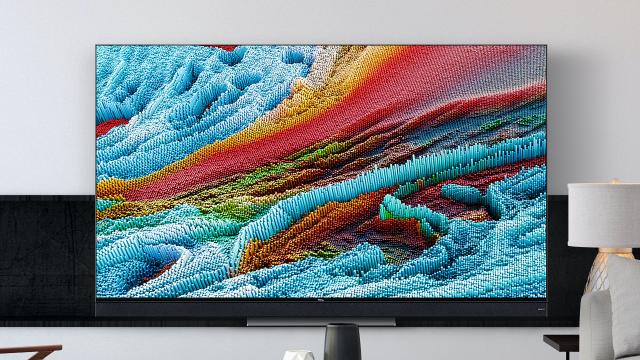Wander into any retailer that sells TVs and you’ll be met with walls – quite literally in these days of ever-expanding TV sizes – of panels all extolling their virtues and price points. At the cheapest end of town LCDs still dominate, but if your budget stretches to mid-high-end TVs, you’ll see a lot of conflicting text praising OLED, QLED and mini-LED.
It’s a battle that can leave you more than a little confused. What’s the real difference between OLED, QLED and mini-LED TVs?
There are numerous brands offering up OLED TVs, with the majority actually relying on panels produced by the display arm of LG Electronics. Yep, that’s right, your fancy new Sony or Panasonic OLED TV is, at one level, actually a fancy new LG TV. Including, of course, the ones sold by LG, although they’re technically LG OLED TVs sold by LG Electronics, not by LG Display.
Yes, sorting out the business structures of Korean TV makers is confusing as hell, but that’s probably not the point.
The primary brand that pushes QLED is also Korean: LG’s arch-rival, Samsung. So does Samsung have some kind of exclusive on exceptional next-generation TV technology that nobody else can match? No, not really. To understand why you have to delve into the way that TV displays are manufactured.
OLED Explained
OLED stands for Organic Light Emitting Diode, which uses organic pixels that emit their own individual lights. This gives them incredible contrast, because each individual pixel can switch fully on or off on its own, if needed.
There’s no need for a heavy or hot backlight, refresh rates are exceptional and because each pixel produces both light and colour, image quality is generally regarded as absolute best-in-class by most TV reviewers.
There are some challenges for OLED, however. While contrast on these sets is amazing, they’re typically not quite as bright as the competing QLED panels, which can create challenges if they’re used in bright environments – although conversely, that means they’re generally preferable when you’re watching movies in a darkened home theatre room.
To date, LG Display has concentrated on building quite large OLED panels, and that means there’s a dearth of smaller – and more affordable – OLED models. If you love the picture quality of OLED, even if you can score a good deal on a set, you’re going to have to put up with a larger TV.
In an ironic quirk, while OLED TV panel manufacture is largely an LG Display business, in the smartphone space where OLED displays are seen as preferable, the primary producer is Samsung.
That’s not just for its own phone such as the Samsung Galaxy S21 Ultra but even competitor handsets like the Apple iPhone 12.
You can get a 55-inch LG OLED B1 Series Smart TV for $2,695, or a Sony 55-inch A8H 4K UHD Android OLED TV for $3,295.
QLED Explained
There’s not much doubt that the naming for QLED exists to invite a little confusion in the minds of TV buyers, because it really is very similar to OLED.
The Q, in this case, stands for Quantum Dot – so strictly speaking it should be QDLED, but that’s hard to say – and the QLED process involves what is basically a standard LED LCD TV, but with nanoparticles – those quantum dots – used to boost colour and contrast capabilities.
You could build a QLED TV that worked like an OLED with each quantum dot emitting its own light and colour, but that’s not quite what you get on a Samsung QLED TV.
Instead, Samsung uses quantum dots in a film in front of an LED panel, so it’s still relying on a regular backlight for the first phase of its panel illumination. As such, compared to OLED, QLED panels tend to be a touch heavier and run warmer over time. However, as noted above, that backlight can make them a slightly better option if you’re placing your TV in a spot where it gets hit with a lot of sunlight because the enhanced illumination can help to deal with glare issues.
There’s a lot more variety in sizing for QLED panels at the time of writing than there are for OLEDs, and that has two effects. Firstly, and pretty obviously you can score a QLED TV for less than an OLED, because they come in smaller sizes. That also means if you’re using an area where a larger TV doesn’t make sense, you may have to settle for a QLED, because smaller OLED TVs really aren’t a thing right now.
You can get a 65-inch TCL C727 4K QLED Android TV for $1,695, or a 75-inch Samsung Q60A 4K UHD QLED Smart TV for $2,495.
Mini-LEDs explained

While still an emerging technology, mini-LEDs could be the future of TV displays. As its name suggests, a mini-LED is much smaller than a standard LED. This allows more of them to be packed together in a single space, giving you more precise backlighting for LCD panels and an increased number of local dimming zones. This results in a better picture and performance, with deeper blacks, enhanced colour reproduction, reduced blooming, improved brightness and a higher contrast ratio.
Leading the charge for mini-LED TVs was TCL, which released its mini-LED 4K 8-Series TV in 2019, which was followed by the popular mini-LED 4k 6-Series. TCL has also released 8K models since then. Mini-LEDs are a best of both worlds situation. The combination of an LCD panel with Quantum Dots and mini-LED backlighting allows for a performance that rivals that of an OLED, with the added benefit of not having to worry about screen burn (more on that in a moment).
In almost all regards, when compared with QLED, a mini-LED TV is the superior backlit display.
Other manufactures have started exploring the possibilities of mini-LEDs, with Samsung, Hisense and LG all having announced TVs that use this technology. Outside of TVs, we’ve seen Apple adopt mini-LED displays with the most recent generation of the iPad Pro, and it wouldn’t be surprising to see it pop up in future products.
You can get a 55-inch TCL C825 4K Mini-LED Android TV for $1,995, or a 75-inch TCL X925 8K Mini-LED Android TV for $5,495.
[related_content first=”1714917″]
The burn-in controversy

Where Samsung tries to score points for QLED over OLED is panel longevity. The nature of the construction of OLED panels raises the spectre of screen burn-in. Ask LG if this is a real issue and they’ll say that most sets under normal use shouldn’t see problems. The use of “shouldn’t” is careful there, because there is the potential for issues over the full life of an OLED panel if you watch the same content, and especially content with sustained persistent images on the screen.
The easiest way to explain that is to think about those onscreen “bugs” that TV channels love to slap onto their content to explain the ownership of it. If you watched a lot of a channel that had that screen ident in place all day, every day, you’re inviting potential burn-in on an OLED panel where that ident sits. QLED and mini-LED don’t have this issue, or at least not anywhere near the same extent, due to the underlying manufacturing process.
That being said, if you swap channels around on a regular basis, you might never see any burn-in issues on an OLED at all.
There’s also MicroLED

There’s been another emerging TV standard, and that’s microLED. Despite the similar name, it’s not to be confused with mini-LED.
Samsung made quite a splash at the 2019 CES shows with its microLED “Wall” TVs, which come in sizes up to 219-inches. No, that wasn’t a typo – Samsung has a TV that may be bigger than the wall in your apartment right now.
MicroLED isn’t really about size, but a technology approach that is in most ways very similar to that of OLED. Where OLED uses organic pixels, microLED uses sets of non-organic LEDs to provide much the same individualised pixel-level brightness and colour control for improved fidelity. Samsung’s claim with microLED is that it’s a best-of-both-worlds situation because you get the “perfect” contrast of an OLED but the brightness benefits of an LED, along with a claimed longer lifespan for the panels altogether.
However, MicroLED is very new technology, and tricky to build, which means that MicroLED TVs are likely to command a price premium over their OLED and especially QLED counterparts for some time to come.
OLED vs QLED vs Mini-LED: which one is better right now?
For most TV purposes, OLED is viewed as the current best-of-breed thanks to its incredible contrast and picture fidelity, as long as you’re happier with a larger TV size – and most of us are – and asking prices for OLED panels.
QLED is a smart evolution of existing technology, and it shouldn’t be discounted when you’re making a TV purchase, especially in those smaller sizes and in the competitive environment of TV sales. If you can score a QLED TV at the right price you’re not likely to be terribly disappointed.
While it’s a relative newcomer, by combining the strengths of OLED and QLED, mini-LEDs are shaping up to be where TV displays are heading. For everything a QLED TV can do, a mini-LED TV can do much better – just at a higher price. A mini-LED TV also comes close to standing toe-to-toe with the performance of an OLED TV and in some respects, like brightness and overall endurance, exceeds it. Manufacturers like TCL are also fairly competitive with its pricing of mini-LEDs against OLEDs, making them a cheaper option when picking up a 4K TV.
